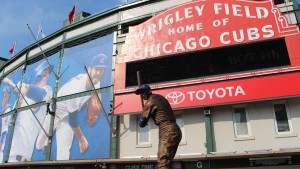Cubs regaining lost fan base
By George Castle For Chronicle Media — October 9, 2015
The Cubs dishearteningly collapsed in their last pair of playoff forays (2007, 2008), then endured a string of poor seasons until the unexpected upsurge to 97 victories this season. In that period of time, the Cubs lost fans due to the consistent losing. (Photo by Nick Hanson/for Chronicle Media)
The Chicago Cubs are sure to regain much of the ground they’ve lost in recent years in the fan rivalry with the St. Louis Cardinals after the two archrivals met for the first time in the postseason.
The rivalry, much of it good-natured unlike the blood-lust New York Yankees-Boston Red Sox duels, will zoom to new heights as the appealing young Cubs tried to knock off a long-established winner in the Cardinals, baseball’s top regular-season team with 100 victories.
The Cardinals have increasingly held the upper hand throughout the traditional rivalry area in central and southern Illinois in the last decade. They’ve won two World Series (2006 and 2011) while otherwise continually reaching postseason play. Many baseball pundits regard the Cardinals as the model franchise in player development.
Meanwhile, the Cubs dishearteningly collapsed in their last pair of playoff forays (2007, 2008), then endured a string of poor seasons until the unexpected upsurge to 97 victories this season. In that period of time, the Cubs lost fans due to the consistent losing. They also ended the second of their two affiliations with the Class A Peoria Chiefs of the Midwest League in 2012. The Cardinals immediately took over the affiliation. And the long-popular mid-January Cubs Caravan ceased its stops in Peoria and Springfield, further eroding fan allegiance and generating bad feelings.
Until the turn of the new millennium, however, the rivalry was virtually split down the middle throughout the state, with radio playing the original pied piper for both franchises.
The long-term results of broadcast sampling turning into ticket-buying featured weekend Cubs-Cardinals games in St. Louis and Chicago drawing huge crowds, with many fans making the long drive from all over Illinois. On June 29, 1969, a standing-room 41,060 squeezed into Wrigley Field for the “Billy Williams Day” doubleheader, with another reported 20,000 turned away at the gates. On July 28, 1963, 40,222 packed in for another Cubs-Cards twin bill — with then-Cub Lou Brock slugging two homers in the nitecap — as the largest Friendly Confines crowd at that point since 1952. And on July 2, 1977, some 50,340 packed Busch Stadium II to watch the Cubs make five errors in the first inning alone on the bouncy artificial turf.
The Cubs’ early pro-radio policy, with as many as seven Chicago stations carrying games by 1931, built up a regional fan base throughout Illinois, as listeners turned into ticket buyers. The Cardinals, though, took that exposure to a new level by the 1950s, when their own radio network reached more than 100 affiliates in a multi-station region. Each central Illinois city’s major station ended up carrying Harry Caray’s St. Louis broadcasts, while originating outlet KMOX’s booming night-time signal covered the entire state.
TV became a big equalizer by the end of the 1960s.
Starting earlier in the decade, TV station executives throughout central Illinois pitched originating Cubs outlet WGN, which had televised all Wrigley Field games since 1948, for a schedule of telecasts. In 1967, WGN set up its own network, beaming Sunday and scattered weeknight-road games all over the state.
Then, in 1968, WGN began airing 60 Cubs road games, further boosting exposure and fan loyalty. The Cubs’ video appeal then dramatically cut into the Cardinals’ backyard via WGN’s superstation exposure starting in 1978 and the hyper-popular Caray’s arrival to helm the telecasts in 1982.
A telling comment about TV’s high ground came in 1999 from Trish Epley of Peoria in the book “The I-55 Series: Cubs vs. Cardinals.”
“I think the Cubs fans have the advantage here,” Epley said. “Growing up, the Cubs games were on WGN, while the Cardinals were not on TV. That’s why I became a Cubs fan.”
Added Peorian Mike Dunne, once the Cardinals’ No. 1 draft choice in 1984: “The Cubs Caravan usually draws more people (than the Cardinals’ caravan) coming through town.”
The first formal survey on Cubs-Cardinals popularity was undertaken with a sample of 500 fans, by CBS-TV affiliates WMBD in Peoria and WCIA in Champaign on Aug. 8-10, 1977. The stations surveyed fan loyalties via 100 respondents each in Champaign, Danville, Bloomington-Normal, Peoria and Decatur.
The Cubs enjoyed huge advantages over the Cardinals in Peoria (50 to 31 percent), Champaign (57 to 24 percent) and Danville (66 to 16 percent). The Cardinals had narrow pluralities in Bloomington-Normal (41 to 40 percent) and Decatur (41 to 37 percent). In a separate tally that displays the White Sox’s lack of a regional fan base that hurts attendance, the South Siders polled more than 5 percent in just one city (8 percent in Bloomington-Normal).
In a new century, social media has picked up the polling of fan loyalties. Facebook has produced several annual county-by-county national maps of sports fans’ “likes” of their favorite franchises.
The dynamics of the Cubs’ decrease of exposure in the Peoria area seems to have had an effect. The Cubs had a narrow edge in Facebook likes (37 to 34 percent) in Peoria County and Woodford County (40 to 36 percent), while the Cardinals had a bigger margin of likes in Tazewell County (42 to 36 percent). The 1977 St. Louis edge in Bloomington-Normal was evolved to a 40 to 27 percent Cubs’ liking in McLean County. Of course, St. Clair County, across the Mississippi from Busch Stadium III, is lopsided in its Cardinals likes (76.4 to 4.4 percent).
But these and other numbers promise to change if the Cubs’ improbable journey continues further into October, past their dramatic date with the Cardinals.
George Castle is a longtime Chicago-based author, writer, broadcast host and sports
— Cubs regaining lost fan base —



